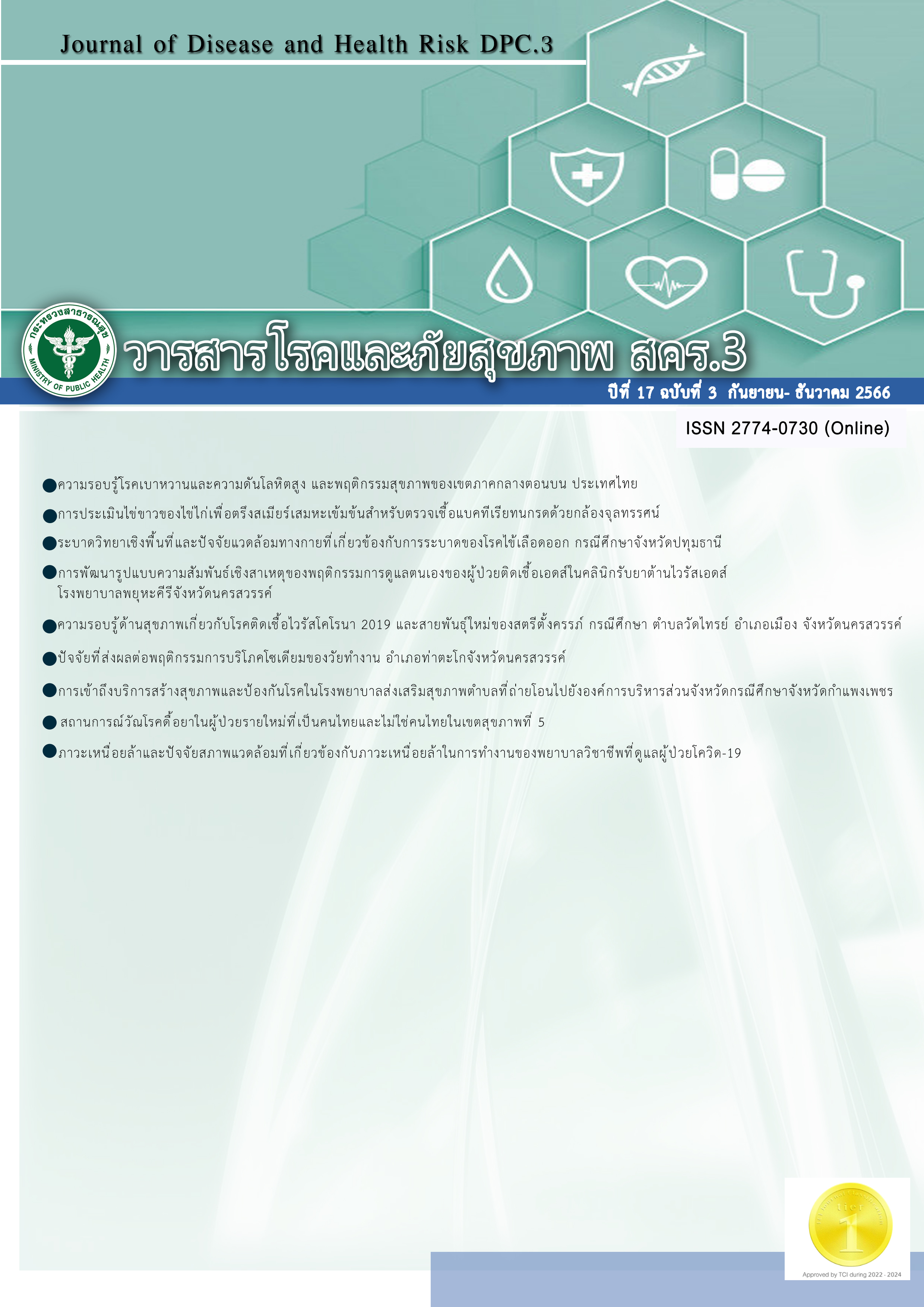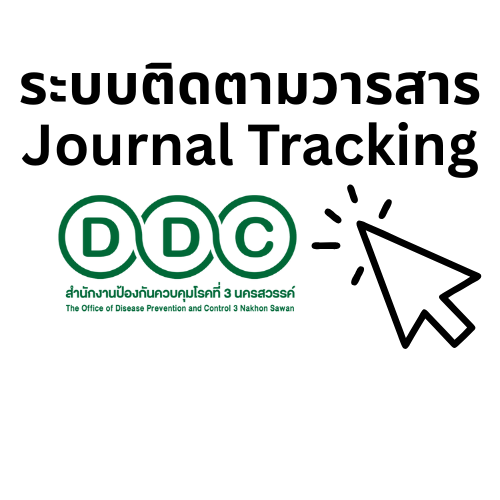Factors Affecting Sodium Consumption Behavior of People in Thatako District, Nakhon Sawan Province
Keywords:
Consumption Behavior, Sodium ConsumptionAbstract
This Cross-sectional Survey research aimed to study the sodium consumption behavior of people and factors affecting the sodium consumption behavior of people in Thatako District Nakhon Sawan Province. The sample group aged 20 – 59 years old, both male and female, totaled 390 people by multistage sampling. The data were collected during January - February 2023. The tool was a questionnaire with a confidence value between 0.72 – 0.92. The data were analyzed by frequency distribution, percentage, mean, standard deviation, and stepwise multiple linear regression at a level of statistical significance of 0.05. The results of the study found that the sample had behaviors about food consumption with moderate levels of salt and sodium 53.30 percent and factors affecting increased sodium consumption behaviors of working ages, Thatako District, Nakhon Sawan Province Statistically significant at the 0.05 level were perceived risk opportunities and severity, age. The factors affecting the decreased sodium consumption behavior were community life, obtaining information from the media and individuals, living in rural areas, and food consumption attitudes. The relevant agencies should consider the results of these predictors when developing. Promote correct behavior regarding sodium-containing consumption. for solving health and nutrition problems continue to be appropriate.
References
World Health Organization. Salt reduction. [Internet]. [cited 2021 Sep 17] Available from: https://www.who.int/news-room/fact-sheets/detail/salt-reduction
Chailimpamontree W, Kantachuvesiri S, Aekplakorn W, Lappichetpaiboon R, Sripaiboonkij Thokanit N, Vathesatogkit P, et al. Estimated dietary sodium intake in Thailand: A nationwide population survey with 24-hour urine collections. Clin Hypertense (Greenwich) 2020; 23(4): 744-754.
Department of Health, Ministry of Public Health. Report on the analysis results according to indicator 1.3, level of success in driving health promotion operations for working age groups in 2021. [Internet]. [cited 2021 Sep 17]; Available from: http://203.157.71.163/kpi/uploads/20210506090518- List of information used for desired behavior_64 round 2. pdf. (in Thai).
Ministry of Public Health. New disease rate of high blood pressure in 2021. [Internet]. [cited 2021 Sep 17]; Available from: https://hdcservice.moph.go.th/hdc/main/index.php. (in Thai)
Division of Non-Communicable Diseases, Ministry of Public Health. Strategy to reduce salt and sodium consumption in Thailand 2016-2025. [Internet]. [cited 2021 Sep 17]; Available from: http://www.thaincd.com/2016/news/hot-news-detail.php?id=13911&gid=18. (in Thai).
Daniel WW. Biostatistics: A foundation of analysis in the health sciences 6th ed. New York: John Wiley & Sons; 1995.
Bloom BS. Mastery learning. In: Block JH, editor. Mastery learning, theory, and practice. New York: Holt, Rinehart & Winston; 1971. p. 47-63
Likert R. The method of constructing an attitude scale. In: Fishbein M, editor. Reading in attitude theory and measurement. New York: John Wiley & Sons; 1967. p. 90-5.
Kannika Suwanna, Walailuck Sittibun, Jira Kaewdam, Lersak Innupaph. Knowledge, Health Belief and Behavior of Salt Consumption among People in Nakhon Sri Thammarat Province. Journal of Health Science, Thaksin University 2020; 2(1):53-61. (in Thai).
Mohammad H. Hossein E., Hassan H., Akbar F. (2021). Salt intake and blood pressure in Iranian children and adolescents: a population-based study. BMC Journal, 21: 62.
https://doi.org/10.1186/s12872-021-01876-z
Sudkhanueng Rotijanachewakon. The Attitudes and Behaviors on Food Consumptions of the Staff in the Sakon Nakhon Hospital. Nursing, Health, and Education Journal. 2019; 2(3):32-42. (in Thai).
Rezaei S, Mahmoudi Z, Sheidaei A, Aryan Z, Mahmoudi N, Gohari K, et al. Salt intake among Iranian population: the first national report on salt intake in Iran. J Hypertens. 2018;36:2380–89.
Sirimon Chaiket. Factors Associated with Sodium from Food Consumption among Students at Srinakharinwirot University, Prasarnmit Campus. J. Res. Unit Sci. Technol. Environ. Learning 2016; 7(1):103-14. (in Thai).
World Health Organization. More than 700 million people with untreated hypertension. [Internet]. [cited 2023 June 21] Available from: https://www.who.int/news-room/fact-sheets/detail/salt-reduction.
World Health Organization. A global brief on hypertension Silent killer, global public health crisis. [Internet]. [cited 2023 June 21] Available from: http://www.who.int/cardiovascular_diseases/publications/global_brief_hypertension/en/.
Division of Non-Communicable Diseases, Ministry of Public Health. Campaign message for World Hypertension Day 2018. [Internet]. [cited 2021 June 21]; Available from: http://thaincd.com/document/file/info/non-communicable-disease/ประเด็นสารวันความดันโลหิตสูง_61.pdf. (in Thai)
Ministry of Public Health. Population by gender, age group, year. [Internet]. [cited 2021 Oct 10]; Available from: http://hdc.ntwo.moph.go.th /hdc/reports/page.php?cat_ id=ac4eed1bddb23d6130746d62d2538fd0. (in Thai).
Pasani Thirakunphrit. Th. Factors Affecting Sodium Consumption Behavior of Households at Bangmak Sub-District, Kantang District, Trang Province.[Internet]. [cited 2021 Oct 10]; Available from: http://research.scphtrang.ac.th/sites/research.scphtrang.ac.th/files/3%20Sukhumaphorn%28Passanee%29_Sodium_0.pdf (in Thai).
Youngiam W, Wattanaburanon A, Keeratisiroj O, Songthap A, Phetphum C, Wangwonsin A. Factors Influencing Sodium Consumption Behaviors among University Employees in Phitsanulok Province, Thailand: A cross-sectional study. J Health Res. 2024; 38(1):correct-correct. DOI: https://doi.org/10.56808/2586-940X.1059
Jureephon Congprasert, Kamolthip Vijitsoonthornkul. The factors related to excess salt and sodium consumption among the population in 4 provinces. Dis Control J. 2022, 48(4), 886-98. (in Thai).
Downloads
Published
How to Cite
Issue
Section
License
Copyright (c) 2023 Journal of Disease and Health Risk DPC.3

This work is licensed under a Creative Commons Attribution-NonCommercial-NoDerivatives 4.0 International License.
Copyright notice
Article published in the Journal of Disease and Health Risk DPC.3 Nakhon Sawan. It is considered a work of academic research and analysis as well as the personal opinion of the author. It is not the opinion of the Office of Disease Prevention and Control 3, Nakhon Sawan. Or the editorial team in any way Authors are responsible for their articles.
Privacy Policy
Name, address and e-mail address specified in the Journal of Disease and Health Risk DPC.3 Nakhon Sawan. It is used for identification purposes of the journal. And will not be used for any other purpose. Or to another person.









